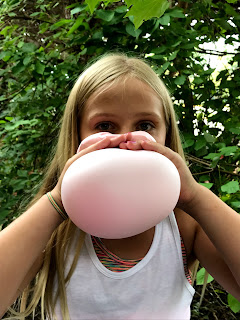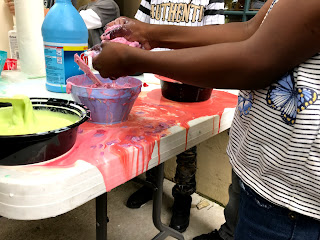At one of our Wild Rumpuses this year, a group of kids turned the orange climbing cube into a jail. This is a pretty common play theme but with complex and specific details (like dates and hashmarks on the wall, discussion of "going back to court" and poor food rations), some of the adults watching the play felt a little uncomfortable. But there is immense value in children playing about a wide variety of topics, especially those that are full of challenging or difficult emotions. Playing through these scenarios helps kids to work out how they feel, trying out different ways to approach the topic in their own minds.
I consulted with Dr. Lawrence Cohen, licensed psychologist specializing in children’s play and author of Playful Parenting and he pointed out that, “For some [children] the theme is actually jail.... For more, the theme is "who is in control," which is a deep theme for all children (given the limits on control that children have over their own lives—which is something this general kind of play is meant to contradict). School can feel like a jail to many children, so jail play is often a way to work through school-related emotions, especially for older children who are not likely to "play school" the way younger children do….Aggressive play often plays with the theme of control (or lack of control) over one's own impulses, and how to handle threats and adversity in life. Important themes! Banning this kind of play is like telling children: no, you can't think about such areas of life. But play is their philosophy class, their practice in moral reasoning, the extension of their highest order levels of thinking.” [emphasis added]
In his book Free to Learn, Peter Gray says, “Even children who have never experienced any particular trauma, beyond the little ones that everyone experiences, often play at emotion-arousing, traumatic scenes. In doing so, they may be steeling themselves to deal with all sorts of unpredictable but inevitable unhappy and painful events.” (p.170)
[the jail]
So how should we as adults respond when these situations arise?
Step 1: Watch and listen to what is actually happening (NOT what we think is happening).
I strongly recommend recording a long video because when you go back and watch it later, you’ll be able to see more than you will if you just rely on your memory (which will be tainted by your own emotional reactions to the play). If someone is in danger of being seriously physically hurt, YES you should step in to ensure safety, but aim for minimal intervention. Listen to what the kids are saying during play -- what looks like one thing to us might be something totally different to the kids who are playing and THEY are the only ones who can tell us what they were really playing.
Step 2: Pay attention to the kids’ emotions.
Dr. Cohen says, “Many adults have trouble telling the difference between real violence and aggressive play. I will give you some suggestions on how to tell them apart. Healthy aggressive play, like all play, is consensual; everyone agrees to be part of the play. In situations of real violence, one child hurts another without their agreement or consent. Aggressive play is meant to be fun, and it is. You will see joy on everyone’s face and you will hear laughter. Aggression is meant to be hurtful, and it is. At least one person ends up miserable, angry, or upset.”
In this particular scenario, none of the children involved showed signs of agitation or distress. Despite some in-character scolding, it was clear that no one was actually angry. When adults are feeling anxious about the play, this is one element to watch for. If some (or all) of the children involved are clearly NOT enjoying themselves, it doesn't necessarily mean that we as adults need to put a stop to the play, but instead we should watch very closely, step in if children are actually getting harmed (physically or otherwise), but if they're just arguing, let it play out and then talk about it with the group after the play is finished.
["FREE DOM!"]
Step 3: Pay attention to your own emotions.
Pay attention to your own internal reactions (but try to keep them internal for now. I KNOW it's hard!). Just recognizing that part of our discomfort lies in our own feelings about the uncomfortable topic is a huge step. Do we have a personal history with this topic? Have we already formed strong opinions and beliefs about this topic (remember, kids are still figuring out their own opinions and beliefs!)? If it’s too challenging for you to watch, is there another caring adult present who can be the careful observer so that you can step away to manage your own anxiety levels?
Step 4: After the play is done, show the video to the children and ask them to talk about their play.
Listen to the kids afterwards and pay attention to what they say about the play, this is the best way to have insight into their experience and to find out what they were thinking and doing.
["git me out"]
Playing through difficult subjects is how kids figure out how their world works. There is great value in children having the chance to work through play that is meaningful and important to them. Sometimes those meaningful things are difficult for adults to watch. We may not know why the kids are playing in these ways, but it’s important to know that for whatever reason, this kind of play is essential to their development. It is a form of highest respect to give them the space to play, even when it makes us uncomfortable.






















































